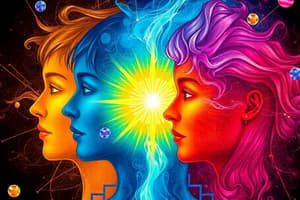Podcast
Questions and Answers
According to Pio-Abreu (2002), which of the following best describes 'humor'?
According to Pio-Abreu (2002), which of the following best describes 'humor'?
- A state of being intensely emotional about something.
- A temporary emotional state.
- A state that remains constant.
- A state that includes feelings of sadness, joy and anxiety. (correct)
According to the material, how do emotions manifest?
According to the material, how do emotions manifest?
- Through reactions that can trigger new emotions in others. (correct)
- As reactions which do not trigger new emotions.
- As private internal states that are not observable.
- Through unchanging physiological reactions.
Which statement accurately differentiates between emotions and sentiments according to the text?
Which statement accurately differentiates between emotions and sentiments according to the text?
- Emotions are directed outwards and sentiments are private. (correct)
- Emotions and sentiments are both internal and private, emotions being of low intensity
- Both emotions and sentiments are directed outwards with the same intensity.
- Emotions are prolonged over time, while sentiments are brief.
How are affects organized in relation to emotions, according to the text?
How are affects organized in relation to emotions, according to the text?
According to António Damásio (2020), how do emotions support homeostasis?
According to António Damásio (2020), how do emotions support homeostasis?
How are 'affects' constructed and manifested, according to the text?
How are 'affects' constructed and manifested, according to the text?
Considering classical authors' perspectives, what distinguishes 'passions' from 'emotions'?
Considering classical authors' perspectives, what distinguishes 'passions' from 'emotions'?
From a behaviorist perspective, what is the focus when studying affective states?
From a behaviorist perspective, what is the focus when studying affective states?
What are the key criteria for an emotion to be considered 'basic,' according to Ortony & Turner (1990)?
What are the key criteria for an emotion to be considered 'basic,' according to Ortony & Turner (1990)?
What should the evaluation of emotions be based on?
What should the evaluation of emotions be based on?
Flashcards
Humor (Pio-Abreu, 2002)
Humor (Pio-Abreu, 2002)
Something you 'walk' with, like sadness, happiness, or anxiety.
Emoção (Pio-Abreu, 2002)
Emoção (Pio-Abreu, 2002)
Something you 'become' as a result of something.
Afeto (Pio-Abreu, 2002)
Afeto (Pio-Abreu, 2002)
Something you 'have,' such as love, compassion, or hate.
Sentimento (Pio-Abreu, 2002)
Sentimento (Pio-Abreu, 2002)
Signup and view all the flashcards
Emoções
Emoções
Signup and view all the flashcards
Sentimentos (feelings)
Sentimentos (feelings)
Signup and view all the flashcards
Afetos
Afetos
Signup and view all the flashcards
Emoções (Damásio, 2020)
Emoções (Damásio, 2020)
Signup and view all the flashcards
Sentimentos (Damásio, 2020)
Sentimentos (Damásio, 2020)
Signup and view all the flashcards
Emoções.
Emoções.
Signup and view all the flashcards
Study Notes
- The subject is the psychology of emotions, specifically the nature and classification of emotions.
Defining Emotions and Related Concepts (Pio-Abreu, 2002)
- Humor: Described as something one "walks with," encompassing feelings like sadness, joy, and anxiety.
- Emotion: Defined as something one "stays with," indicating being emotionally moved by something.
- Affect: Characterized as something one "has," including feelings such as love, compassion, pride, and hate.
- Sentiment: Considered the combination of humor, emotion, and affect, holding significant importance in understanding the psyche.
Nature and Classification of Emotions
- Emotions are triggered by events (person, situation) that are cognitively evaluated, though not always consciously.
- Emotions involve subjective experiences and can be accompanied by physiological reactions like changes in heart rate, muscle tone, facial expressions, gestures, movements, and vocal expressions.
- Emotions translate into a tendency for action, such as fleeing in fear.
- Expressions of emotions can trigger reactions in others, potentially leading to new emotions.
- Sentiments are internal and private states, not outwardly observable like emotions; sentiments last longer and are less intense compared to emotions.
- Emotions are outwardly directed and public, serving a communicative function with high intensity and short duration.
- Affect is expressed through emotions and organized by repeated emotional experiences.
- Affects such as love or hate, are experienced intensely as emotions.
- Affects are linked to the past and built over time, while emotions are realized in the present, both involving a relationship.
António Damásio's (2020) Perspective
- Emotions: They are involuntary internal and external actions triggered by external stimuli, real or recalled, supporting homeostasis, such as reacting to threats with fear or anger, or signaling success with joy.
- Emotions also produce emotions and feelings and are produced when we recall events.
- Sentiments: They are mental experiences accompanying the body's homeostatic states, whether primary (hunger, thirst) or triggered by emotions (fear, anger, joy).
Further Insights on Emotions
- Emotions represent the external and dynamic manifestation of one's internal affective state, making them observable.
- Emotions are evaluated by type, intensity, extension, variability, and congruence with the context of conversation.
- Psychiatric disorders can significantly alter mood or emotions, like major depression or anxiety disorders.
Classical Authors' Perspectives on Emotions
- Emotions: Arent intense affective phenomena that arise quickly and fade quickly.
- Sentiments: These phenomena are stable affective states resulting from an intellectulization of emotions; they lose intensity through rational analysis, becoming stable, lasting, and less intense.
- Passions: They are intense affective phenomena, as emotions are, but they remain unintellectualized for a relatively long time, which causes extreme intensity work to nervous system with a possibility of exhaustion and disruption
- Behaviorist Authors: They focuses on systematizing physiological reactions accompanying affective states of consciousness.
- "Immediate Affective Response" corresponds to emotion, while secondary affects are at the origin of the intellectualization of emotions, with their persistent effects being sentiments and passions.
Basic Emotions
- There is no universal scientifical definition of emotion.
- Basic emotions consensus is greater, but definition and number can vary with theories.
- Ortony & Turner (1990) defined criteria for basic emotions: Distinctive physiology, Universality, and Innatism
- Fundamental emotions or elementar emotions can be used to construct non-basic emotions
- Elementar emotion can not be decomposed
Components of Emotions
- Components of emotion include:
- Cognitive - awareness of the emotions
- Evaluative - values, interests, and objectives
- Physiological - heart rate, breathing and paleness
- Expressive - tone of voice, facial expressions, body language etc
- Behavioral - aggression, avoiding or controlling oneself
- Subjective - state of emotion
Emotion avaliation
- The emotion avaliation should consist of these indicators:
- Expressive Behaviour
- Physiological Indicators
- Experienced emotion and describing it
Suggested films and games related to emotions
- The document contains a list of films and games related to emotions
Studying That Suits You
Use AI to generate personalized quizzes and flashcards to suit your learning preferences.




